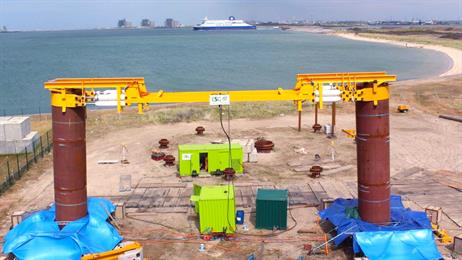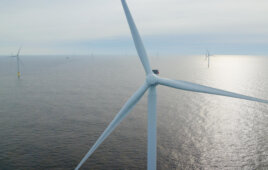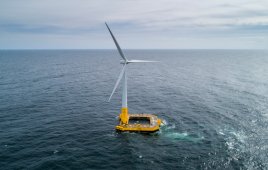
A total of 28 piles on two sites were tested in a joint project between DONG Energy and ESG to assess and validate the potential of new design methods for offshore wind farms.
DONG Energy and ESG have just completed one of the most comprehensive pile-testing campaigns ever. Initial results show great cost reduction potential for the offshore wind industry.
The two wind companies have tested 28 piles on two different onshore sites to assist the development of new design methods for offshore wind farms. The testing has been undertaken by the joint industry project PISA. It was performed to assess and validate a new design method developed by the PISA academic working group, as led by Oxford University, including Imperial College London and University College Dublin.
The academic working group supervised the testing on site, as each of the 28 piles were pulled sideways into the soil until failure.
Alastair Muir Wood, Lead Geotechnical Engineer DONG Energy and Technical Manager for the PISA Project, said: “We’re very pleased with the test results, which confirm that traditional design methods in these soils are very conservative. The results indicate that in these site conditions there may be opportunities for savings identified by reducing the quantity of steel in the foundation. In other words, there’s a savings potential, that will contribute to reducing the cost of electricity.”
The testing took place in Cowden, England, and in Dunkirk, France. The clay till site in Cowden and the dense sand site in Dunkirk represent typical surface soil conditions found in much of the North Sea. Furthermore, both sites have previously been used for pile testing activities, mostly targeting oil and gas engineering, meaning that a rich amount of field and laboratory soil data is already available.
Applying a load of 37 London buses
Bladt and Dansteel supplied piles of three different diameters for the tests; the piles with a diameter of two meters are some of the largest ever tested. During testing, other instrumentation was used including fibre optic strain gauges installed by Marmota Industries. In total, 28 tests were conducted primarily investigating the static monotonic but also the response under cyclic lateral loading.
Steve Turner, Project Director from ESG, who undertook the testing, said: “The PISA project has provided some of the most challenging testing we’ve ever undertaken. With the largest test, we were simultaneously monitoring more than 250 different precision instruments, while applying a load greater than the weight of 37 London double-decker buses.”
The PISA academic working group now has six months to analyze the data collected and use it to confirm the new design methods. Their final report is due to be delivered to the project partners in January 2016.
Jesper Skov Gretlund, R&D Project Manager, said: “The PISA Project is a great example of inter-industry collaboration to solve a common problem. If the thickness or length of the steel piles can be reduced by even a small fraction, the saving in cost is quite considerable since smaller construction vessels can be used and larger turbines constructed. The next challenge is to analyze all of the data collected in order to refine our methods and apply these findings to our foundation designs.”
This testing has been undertaken as part of the research project PISA (pile-soil analysis), which is being carried out by an industry working group headed by DONG Energy and involving EDF, RWE, Statoil, Statkraft, SSE, Scottish Power, Vattenfall, Alstom and Van Oord. PISA is being run under the framework of the Carbon Trust Offshore Wind Accelerator (OWA).
DONG Energy
www.dongenergy.com
Filed Under: Offshore wind




